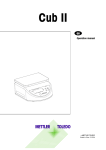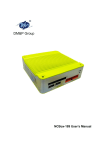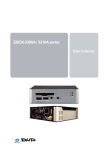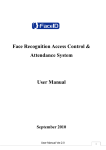Download User manual
Transcript
BLACK & WHITE CAMERA 1/3” INTERLINE TRANSFER CCD HIGH RESOLUTION Smartec STC-1000 USER’S MANUAL www.smartec-security.eu WARNINGS AND CAUTIONS TO REDUCE THE RISK OF FIRE OR ELECTRIC SHOCK, DO NOT EXPOSE THIS PRODUCT TO RAIN OR MOISTURE. DO NOT INSERT ANY METALLIC OBJECTS THROUGH THE VENTILATION GRILLS OR OTHER OPENINGS ON THE EQUIPMENT. CAUTION EXPLANATION OF GRAPHICAL SYMBOLS The lightning flash with arrowhead symbol, within an equilateral triangle, is intended to alert the user to the presence of uninsulated “dangerous voltage” within the product’s enclosure that may be of sufficient magnitude to constitute a risk of electric shock to persons. The exclamation point within an equilateral triangle is intended to alert the user to the presence of important operating and maintenance (servicing) instruction in the literature accompanying the product. FCC COMPLIANCE STATEMENT INFORMATION TO THE USER: THIS EQUIPMENT HAS BEEN TESTED AND FOUND TO COMPLY WITH THE LIMITS FOR A CLASS B DIGITAL DEVICE, PURSUANT TO PART 15 OF THE FCC RULES. THESE LIMITS ARE DESIGNED TO PROVIDE REASONABLE PROTECTION AGAINST HARMFUL INTERFERENCE IN A RESIDENTIAL INSTALLATION. THIS EQUIPMENT GENERATES, USES AND CAN RADIATE RADIO FREQUENCY ENERGY AND, IF NOT INSTALLED AND USED IN ACCORDANCE WITH THE INSTRUCTIONS, MAY CAUSE HARMFUL INTERFERENCE TO RADIO COMMUNICATIONS. HOWEVER, THERE IS NO GUARANTEE THAT INTERFERENCE WILL NOT OCCUR IN A PARTICULAR INSTALLATION. IF THIS EQUIPMENT DOES CAUSE HARMFUL INTERFERENCE TO RADIO OR TELEVISION RECEPTION, WHICH CAN BE DETERMINED BY TURNING THE EQUIPMENT OFF AND ON, THE USER IS ENCOURAGED TO TRY TO CORRECT THE INTERFERENCE BY ONE OR MORE OF THE FOLLOWING MEASURES: - REORIENT OR RELOCATE THE RECEIVING ANTENNA - INCREASE THE SEPARATION BETWEEN THE EQUIPMENT AND RECEIVER - CONNECT THE EQUIPMENT INTO AN OUTLET ON A CIRCUIT DIFFERENT FROM THAT TO WHICH THE RECEIVER IS CONNECTED - CONSULT THE DEALER OR AN EXPERIENCED RADIO/TV TECHNICIAN FOR HELP CAUTION: CHANGES OR MODIFICATIONS NOT EXPRESSLY APPROVED BY THE MANUFACTURED COULD VOID THE USER'S AUTHORITY TO OPERATE THE EQUIPMENT. THIS CLASS B DIGITAL APPARATUS COMPLIES WITH CANADIAN ICES-003. CET APPAREIL NUMÉRIQUE DE LA CLASSE B EST CONFORME À LA NORME NMB-003 DU CANADA. IMPORTANT SAFEGUARDS 1. READ AND RETAIN INSTRUCTIONS Read the instruction manual before operating the equipment. Retain the manual for future reference. 2. CLEANING Turn the unit off and unplug from the power outlet before cleaning. Use a damp cloth for cleaning. Do not use harsh cleansers or aerosol cleaners. 3. ATTACHMENTS Do not use attachments unless recommended by manufactured as they may affect the functionality of the unit and result in the risk of fire, electric shock or injury. 4. MOISTURE Do not use equipment near water or other liquids. 5. ACCESSORIES Equipment should be installed in a safe, stable location. Any wall or shelf mounting accessory equipment should be installed using the manufacture’s instructions. Care should be used when moving heavy equipment. Quick stops, excessive force, and uneven surfaces may cause the equipment to fall causing serious injury to persons and objects. 6. 7. VENTILATION Openings in the equipment, if any, are provided for ventilation to ensure reliable operation of the unit and to protect if from overheating. These openings must not be blocked or covered POWER SOURCES The equipment should be operated only from the type of power source indicated on the marking label. If you are not sure of the type of power supplied at the installation location, contact your dealer. For equipment designed to operate from battery power, refer to the operating instructions. 8. GROUNDING OR POLARIZATION Equipment that is powered through a polarized plug (a plug with one blade wider than the other) will fit into the power outlet only one way. This is a safety feature. If you are unable to insert the plug fully into the outlet, try reversing the plug. Do not defeat the safety purpose of the polarized plug. Alternate Warning: If the equipment is powered through a three-way groundingtype plug, a plug having a third (grounding) pin, the plug will only fit into a grounding-type power outlet. This is a safety feature. Do not defeat the safety purpose of the grounding-type plug. If your outlet does not have the grounding plug receptacle, contact your local electrician. 9. CORD AND CABLE PROTECTION Route power cords and cables in a manner to protect them from damage by being walked on or pinched by items places upon or against them. 10. LIGHTNING For protection of the equipment during a lightning storm or when it is left unattended and unused for long periods of time, unplug the unit from the wall outlet. Disconnect any antennas or cable systems that may be connected to the equipment. This will prevent damage to the equipment due to lightning or powerline surges. 11. OVERLOADING Do not overload wall outlets and extension cords as this can result in a risk of fire or electric shock. 12. SERVICING Do not attempt to service the video monitor or equipment yourself as opening or removing covers may expose you to dangerous voltage or other hazards. Refer all servicing to qualified service personnel. 13. DAMAGE REQUIRING SERVICE Unplug the equipment from the wall outlet and refer servicing to qualified service personnel under the following conditions: A. B. C. D. E. F. When the power supply cord or the plug has been damaged. If liquid has spilled or objects have fallen into the unit. If the equipment has been exposed to water or other liquids. If the equipment does not operate normally by following the operating instructions, adjust only those controls that are covered by the operating instructions. Improper adjustment of other controls may result in damage to the unit. If the equipment has been dropped or the casing damaged. When the equipment exhibits a distinct change in performance. 14. REPLACEMENT PARTS When replacement parts are required, be sure the service technician uses replacement parts specified by the manufacturer or that have the same characteristics as the original part. Unauthorized substitutions may result in fire, electric shock, or other hazards. 15. SAFETY CHECK Upon completion of any service or repairs to the equipment, ask the service technician to perform safety checks to verify that the equipment is in proper operating condition. 16. FIELD INSTALLATION The installation of equipment should be made by a qualified service person and should conform to all local codes. TABLE OF CONTENTS INTRODUCTION ..........................................................................1 SYSTEM INSTALLATION ............................................................2 CAMERA OVERVIEW ..................................................................4 MANUAL IRIS LENS ADJUSTMENT............................................7 VIDEO AUTO IRIS INSTALLATION & ADJUSTMENT ...............11 DC AUTO IRIS LENS INSTALLATION & ADJUSTMENT ...........13 BACK FOCUS ADJUSTMENT ...................................................14 ZOOM LENS BACK FOCUS ADJUSTMENT..............................15 TROUBLESHOOTING AND MAINTENANCE ............................16 SPECIFICATIONS......................................................................18 THIS PAGE INTENTIONALLY LEFT BLANK BLACK & WHITE CAMERAS HIGH RESOLUTION INTRODUCTION BLACK AND WHITE CAMERA The High resolution black and white security cameras provides quality images for use in closed circuit television (CCTV) and security surveillance applications. Features: • High performance 1/3” Interline Transfer CCD : BW • Resolution: 570 lines • • • • • • • • • B/W 0.08 lux @ F1.4 sensitivity Supports standard C or CS mount lenses Equipped with electronic iris Adapts to Video or DC auto iris lenses through dip switch setting Quick connection to auto iris lens with 4-pin connector AGC adjustment Include BLC function 230V AC or 24V AC power or 12V DC power IMPORTANT: The user of this camera is responsible for checking and complying with local, state, and federal laws and statutes concerning the recording and monitoring of audio signals. SYSTEM INSTALLATION Installation of the camera must be performed by qualified service personnel in accordance with all local and national electrical and mechanical codes. Perform the following steps to install the camera. 1. Remove all components from the package and identify the items that will be used during installation. • • • • The camera with the CS lens mount Mini din connector (for Video and DC type auto iris lenses) C mount ring Instruction manual Other items used during the installation that are NOT supplied with the camera may include: • • • • • • 24V AC power supply or 12V DC power supply Camera lens Camera stand or mounting bracket Video cable Monitor Mounting hardware 2. Select a suitable location for the camera. Install the camera stand or mounting bracket in the selected location using a suitable fastener. The camera stand or mounting bracket must be attached to a structural object, such as a wall stud or ceiling rafter, that supports the weight of the camera and mount. The minimum recommended load rating for the bracket is 5 kg (11 lbs). 3. Attach the camera to the camera stand or mounting bracket using the hardware supplied with the stand. The hardware connects to the 1/4” – 20 UNC threaded mounting hole on the top and bottom of the camera housing. Note: The mounting bracket on the camera housing can be attached to the top or bottom of the housing to accommodate various installation options. 4. Route the video cable from the monitor to the camera. 5. Plug the cable into the BNC output connector labeled “VIDEO OUT” on the back of the camera. 6. Plug the other end of the cable into the video input port on the back of the monitoring device. On 24V AC models: 7. Connect a two-conductor power cable from the power supply to the 24V AC input on the back of the camera. 24V AC CLASS 2 “Use of Listed Class 2 Power Source” ~ 8. G ~ Apply 24V AC power to the camera. On 230V AC models: 7. Plug the power cord into a wall outlet. 8. Apply 230V AC power to the camera. 9. Adjust the camera back focus, lens focus, and iris controls for an optimum picture. BLACK and WHITE (B/W) CAMERA OVERVIEW SIDE VIEW C Mount Ring Back Focus Lock Screw ( C MOUNT LENS ) ( CS MOUNT LENS ) Camera Mounting Bracket Back Focus Ring BACK VIEW (24V AC) Power LED V. Phase Potentiometer Level potentiometer (for DC type A/I lens) Function Switch Power Input Terminal BACK VIEW (230V AC) LEVEL PHASE PWR ON DC ON OFF VID OFF E/I A /I A GC Auto Iris Lens Connector LENS AC Power cord ~ G ~ 24VAC CLASS 2 VIDEO OUT Video Out BNC Connector FRONT VIEW LEVEL PHASE PWR ON DC OFF VID E/I A /I ON LENS OFF A GC A C 2 3 0 V IN VIDEO OUT 1. Back Focus Ring This ring is used to adjust the back focus length (distance between the CCD and the back of the lens) by rotation of the ring in a clockwise or counter-clockwise direction. 2. Back Focus Lock Screw The lock screw locks the back focus ring after adjusting. 3. Auto Iris Lens Connector The auto-iris lens connector supplies either a video signal or DC control signal to an auto iris lens. A standard 4-pin din connector interfaces to any auto iris lens. 4. Mounting Bracket Hole The threaded holes (1/4” – 20) are used to mount the camera onto a mounting bracket or tripod. 5. Function Switch The functions of the dip switch settings are explained below. ON OFF ON OFF E/I DC VID A/I ON Switch Alignment Position of switch OFF AGC Status of switch UP ON DOWN OFF *Except A/I function A. E/I (Electronic Iris) (SW1) The E/I automatically varies the camera’s shutter to mimic auto iris control, allowing fixed or manual iris lenses to be used in a wider range of applications. B. A/I (Auto Iris) (SW2) The A/I switch is used to select the appropriate auto iris control signal to the lens. DC: Select for use with a DC auto iris lens VID: Select for use with a video auto iris lens SWITCH POSITION UP DOWN A/I SETTING DC VIDEO E/I SETTING OFF OFF C. AGC (Auto Gain Control) (SW3) The AGC feature keeps signals at a constant level. This control is useful when using the camera at low light levels or when light levels change over time. 6. PHASE Adjustment Phase adjustment is used in a multi-camera system when power is supplied from different sources, causing the cameras to be out of phase. This situation affects the auto-switching of the camera by causing a vertical flip or roll during the switch interval. The vertical phase adjustment allows the camera’s line lock sync to be adjusted from 0 to 300 degrees with reference to the zero line crossing of the AC power source. • • Ensure that all cameras are powered from the same electrical source and wired in a similar manner. Adjust the phase control on the back of the camera until there is no vertical flip or roll on the monitor when using an auto-switcher. 7. LEVEL Adjustment The LEVEL control adjusts the level of the auto iris when the A/I lens selection switch is set to the DC position and a DC lens is mounted on the camera. The A/I switch should be in the “vid” position when a video type auto iris lens is used. The LEVEL adjustment does not apply to video type A/I lenses, only DC lenses. 8. Video Output Connector (BNC) A 1.0Vp-p, 75 ohm composite video signal is provided to this output connector. 9. Power Input Terminal (24V AC model) The power input terminal accepts 24V AC power from a UL listed Class 2 supply. 10. Power LED The green power LED illuminates when power is supplied to the camera. VIDEO AUTO IRIS INSTALLATION & ADJUSTMENT The camera supports video-type auto iris lenses which adjust to changing light levels. Perform the following steps to install and adjust a video-type auto iris lens. 1. If necessary, solder the lens control wires to the connector supplied with the camera. Connector Cover Rib Pin 3 Automatic Iris Lens Pin 1 Pin 4 Heat Shrinkable Tubes Iris Control Pin 2 Cable Connector PIN 1 2 3 4 2. NAME Voltage + Open Video Ground WIRE COLOR Red White Black Attach the video-type auto iris lens to the lens mount on the front of the camera. 3. Plug the connector from the lens into the auto iris jack on the back of the camera. The connector is polarized and can only be inserted into the jack one way. 4. The E/I switch should be in the “OFF” position. 5. The A/I switch should be in the “VID” position. 6. Apply power to the camera. 7. Adjust the focus ring on the lens for an optimum picture. If a picture is not visible, set the lens for proper exposure by adjusting the ALC (Automatic Level Control) and the level on the lens. The ALC setting can range between AVG (average) or PK (peak). A midrange setting is appropriate for most applications. For ALC adjustments: AVG To slow the reaction of the lens to changing light, set the range to the AVG setting to average the video level from the camera. Use when there are bright spots in the picture such as lights or glare from the sun. PK To increase the speed of the lens reaction to the changing light, set the lens adjustment to PK so the lens will adjust to the brightest or peak object in the video. Use this setting if you want to see the brightest object and not the background objects. For Level adjustments: Adjust the level control for the best picture during the day. A night adjustment may not provide the proper setting for controlling the light during the day. 8. Set the back focus of the camera before the final adjustment of the video level. 9. If the auto iris has a gain adjustment and the picture oscillates between open and closed under bright lights, slowly turn the gain adjustment counter clockwise until the oscillating stops. Increase the light getting to the camera by adjusting the level control and re-adjusting the gain control. DC AUTO IRIS LENS INSTALLATION & ADJUSTMENT The camera supports DC-type auto iris lenses. Perform the following steps to install and adjust a DC-type auto iris lens. 1. Solder the lens control wires to the connector supplied with the camera. Connector Cover Rib Pin 3 Automatic Iris Lens Pin 1 Pin 4 Heat Shrinkable Tubes Iris Control Pin 2 Cable Connector PIN 1 2 3 4 2. NAME Damp Coil Damp Coil + Drive Coil + Drive Coil - WIRE COLOR Blue Red White Green Attach the DC-type auto iris lens to the lens mount on the front of the camera. 3. Plug the connector into the auto iris jack on the back of the camera. The connector is polarized and can only be inserted into the jack one way. BACK VIEW 4. The E/I switch should be in the “OFF” position. 5. The A/I switch should be in the “DC” position. 6. Apply power to the camera. 7. Adjust the auto iris lens for an optimum picture using the LEVEL control on the back of the camera. BACK FOCUS ADJUSTMENT For best results, perform back focus adjustments at night or while using a #6 or #8 welders glass in front of the lens. The focus of the camera will change slightly if the camera iris was adjusted on a light scene, then changes to a dark scene. However, the camera will remain in focus if the iris was focused on a dark scene and the scene lightens. 1. The lens should be mounted on the camera before applying power. 2. If a picture is visible, focus on the picture. If the picture is not visible, open the iris on the lens. Open the lens as wide as possible by placing the welder’s glass in front of the lens and forcing the lens to automatically open. 3. When the iris is open to the widest point, re-adjust the focus for clear picture. If a clear picture is not possible, set the focus ring to midrange. 4. Loosen the back focus lock screw. 5. Adjust the back focus ring for a clear picture. 6. Tighten the back focus lock screw. 7. Fine tune the focus with the focus ring on the lens. 8. Remove the welder’s glass from in front of the lens. 9. Adjust the iris of the lens for the best picture quality. ZOOM LENS BACK FOCUS ADJUSTMENT The objective of back focusing a zoom lens is similar to that of a fixed focal length camera except the back focus is also adjusted to maintain the focus when “zooming” the lens in and out on a scene. 1. Choose an object at the farthest range set for viewing with a zoom lens. 2. Make sure the iris of the lens is wide open. Do this by adjusting the camera at night or use a welders glass in front of the lens. 3. Adjust the focus to the stop on the far range. 4. Adjust the zoom on the lens to obtain the widest picture. 5. Loosen the back focus lock screw. 6. Adjust the back focus ring for the clearest picture. 7. Tighten the back focus lock screw. 8. Adjust the zoom on the lens to the far telephoto position. 9. Adjust the back focus ring for the clearest picture. 10. Adjust the zoom on the lens back to the widest picture. 11. Loosen the back focus screw. 12. Re-adjust the back focus for the clearest picture. 13. Tighten the back focus lock screw. 14. Repeat the previous steps as necessary to maintain a clear picture throughout the entire zoom range. TROUBLESHOOTING AND MAINTENANCE Troubleshooting If problems occur, verify the installation of the camera with the instructions in this manual and with other operating equipment. Isolate the problem to the specific piece of equipment in the system and refer to the equipment manual for further information. PROBLEM No Video Video but no control Dark Video AREA TO CHECK 1. Verify power is applied to all pieces of the equipment in the system. The camera LED should be ON. 2. Verify that the video cables are connected correctly. 3. Verify that the lens cap has been removed from the lens and the iris of the lens is open. Power down the system for one minute then re-apply power. 1. Adjust iris. 2. Check A/I connections. Preventive Maintenance Preventive maintenance allows detection and correction of minor faults before they become serious and cause equipment failures. Every three months perform the following maintenance: 1. Inspect all connecting cables for deterioration or other damage. 2. Clean components with a clean damp cloth. 3. Verify that all mounting hardware is secure. THIS PAGE INTENTIONALLY LIGHT BLANK. SPECIFICATIONS : Power Power source Power consumption Sensor Information Image sensor Chip size Picture element Scanning system Scanning frequency ( BLACK and WHITE CAMERA ) 24V AC, 60Hz or 24V AC, 50Hz or 230V AC, 50Hz or 12V DC Max. 4.5 W at 24V AC Max. 5.0 W at 230V AC 1/3” CCD 6.0mm (H) x 4.96mm (V) 768 (H) x 494 (V) EIA 752 (H) x 582 (V) CCIR Temperature / Humidity 2:1 interlace 15.75 KHz, 60 Hz EIA 15.625 KHz, 50 Hz CCIR Line lock 0º to 300 º 1/60 ~ 1/100,000 sec EIA 1/50 ~ 1/100,000 sec CCIR 14º F to 122º F (-10º C to 50º C), < 96% Video Signal format Resolution Minimum illumination Video output S/N ratio BLC size Sync level Electronic iris Auto iris BLC AGC Vertical phase DC iris level 525 lines EIA / 625 lines CCIR 570 TV lines 0.08 Lux 1.0Vp-p, 75 ohms 46dB (AGC OFF) 40% center 40 IRE On/Off selectable Video / DC selectable On fixed On/Off selectable Adjustable Adjustable Sync system Vertical phase adj. Electronic shutter Connectors & Mechanical Video output Power input Auto iris connector Lens mount Mounting hole Dimensions Weight BNC connector 3-pin terminal block at 24V AC model Power cord at 230V AC model 4-pin mini din C or CS mount 1 / 4” - 20 UNC top and bottom 2.4W x 2.1H x 5.0D” (62W x 54H x 127D mm) 0.715 lb (325 g) at 24V AC model 1.111 lb (505g) at 230V AC model






























